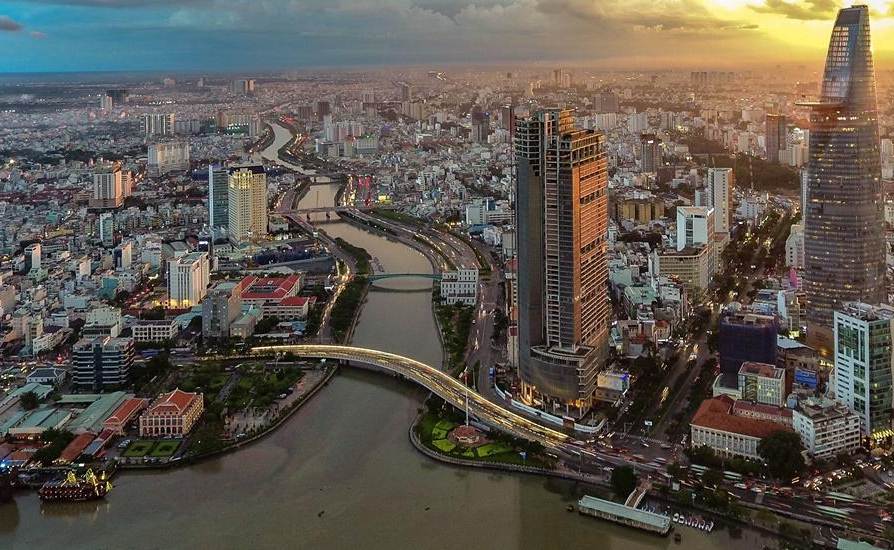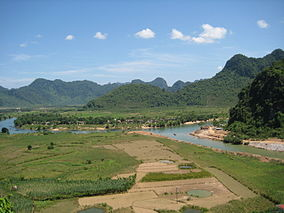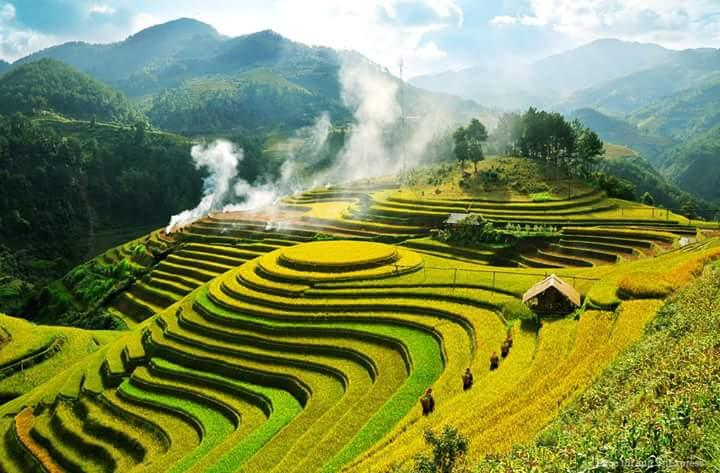18 Best Places to Visit in Vietnam
Vietnam is a long narrow country bordering the South China Sea between the countries of Laos and Cambodia. It is wonderfully diverse with beautiful beaches, thick jungles, sprawling rice paddies, and dazzling mountains. Today, vietnam is quickly becoming a destination travel spot for adventurous American looking to stretch their dollar. Some love it so much they turn into virtual workers, making Vietnam a second home. Maybe you aren’t ready to become a permanent resident, but you want a unique place with lots to see and do without breaking the bank.
Most Americans know a little about Vietnam because of our long complicated history with the country. There is a great possibility you interact with Vietnamese in America because of massive immigration that took place in the late 70’s and 80’s. You may have even sampled a Vietnamese staple, a wonderful, tangy bowl of Pho. What you may not know is that Vietnam was once ruled for thousands of years by various Chinese dynasties until 983 AD until they became an independent country. Later the French took colonial control in the 19th century. The remnants of French culture still remain primarily in their food and some architecture. One of their most famous sandwiches the Banh Mi is a combination of French Baguette bread with tasty Vietnamese ingredients.
Here are the 18 best places to see in Vietnam:
1. Halong Bay
Halong Bay is a beautiful set of islands and formations off the Northern Coast of the country. It has even been declared a UNESCO World Heritage Site. Halong is located about 80 miles from Hanoi.
Not only are the exterior views tremendous, but you can explore caves in the bay along with 3 mammoth caverns. Most travelers enjoy cruising through the bay admiring the constantly changing scenery. On the thousands of islands scattered among the bay, you will see free roaming monkeys and indigenous antelope roaming the larger islands. Many of the larger islands have beaches you can visit. Boat tours are available for every price point. Many of these tours will provide meals and nightlife activities.

The best time to visit Halong Bay is between March and June so you can avoid the rainy season. However, June to September is the off season and you can find some great deals, but bring rain gear for the unexpected monsoon.
2. Ho Chi Minh City
Formerly known as Saigon, Ho Chi Minh is the largest city in Vietnam. It was renamed when Saigon fell to the north in 1975. For an experience of the sites and sounds of a big commercial hub, Ho Chi Minh city needs to be on your list. You will find the best shopping, street food, and restaurant scene in Ho Chi Minh. The center district of the city is known as Dong Koi. Small streets and unique architecture line the district. Even the grand Norte Dame Cathedral left by French colonials is worth a visit.

Da Kano is the oldest district combining French colonial buildings and the Pagoda of the Jade Emperor. It is a real mix of multiple cultures with Buddhist and Taoist iconography on every corner. You can even visit the Historical Museum of Vietnam for a picture of the countries proud heritage. For history buffs, you don’t want to miss the Reunification Palace and the War Remnants Museum.
3. Hue
Hue is one of Vietnam’s most historic towns, located in the Central Region of the country. You can find relics of the reign of the 19th century Nguyen emperors. The Imperial Enclosure (often called the Citadel) is set on the banks of the Perfume River and sprawls for over 1 mile. Inside the Enclosure you will find the Ngo Mon Gat, the Thai Hoa Palace and the Dien Tho Residence. Day cruises are available along the Perfume River where you will see the outside of the Enclosure along with several royal tombs including the Tomb of Tu Doc and the Thien Mu Pagoda.

4. Phong Nha-Ke Bang National Park
Phong Nha-Ke Bang National Park is perfect if you are fascinated by caves. It is also a World Heritage site. The park is located in the Quang Binh Province of the Central Coastal region. Many of the caves are “wet caves” and allow for swimming and relaxing in the water. The Son Doong cave is a must visit. Inside is a hidden jungle, underground river, and unique microclimate in one of the largest caves on Earth.

5. My Son
My Son is near the city of Hoi An, on the central coast is surrounded by lush jungle covered mountains. In My Son, you will find the Hindu past of Vietnam. An ancient Hindu temple dating from the 4th century still survives. It was an active Hindu center until the 13th century.
Once containing more than 70 temples, many of the ruins still remain with decorative carvings and sculptures of animals, priests, gods, and mythical battles. If you are lucky, you watch live Champa dance performances. You won’t go hungry in My Son either. Lining the streets you can find cafes, food vendors, and plenty of souvenir shops.

6. Hoi An
Most people consider this the most atmospheric city in Vietnam due to the historic architecture scattered throughout the city. Many houses still existing dating back to the 15th century when it was the meeting point for Japanese and Chinese merchants. The most famous of these houses is the 17th century Tan Ky House. Your trip to Hoi An is not complete without a visit to the famous Japanese Bridge and the Assembly Hall of the Fuijan Chinese Congregation. Hoi An is located on the Central Coast district of Vietnam and located near some of the most beautiful warm water beaches in the country.
7. Sapa Countryside
The Sapa Countryside is surrounded by deeply rich rice fields, and bordered by the peaks of the Hoang Lien Mountains. Sometimes these mountains are still referred to by their French name, the Tonkinese Alps. This area of the country is found in the Northern border of Vietnam next to China. It is home to a diverse mix of the country’s enthnic minorities, including the Hmong, Giay, and the Red Dzao people. Sapa is a top trekking destination in Vietnam full of adventure among the tiny villages that cluster in this region.

Once in Sapa, you will notice the altitude. It rises 5000 feet above sea level, so be prepared when trekking to drink plenty of water, if you aren’t acclimated to higher elevations. In the town of Sapa, for which the valley is named, are many French colonial sites worth visiting such as a Gothic church. This is the major market town of the area and you can find unique handcrafts you won’t be able to find anywhere else in the world.
8. Hanoi
Hanoi is the capital city of Vietnam and the heartbeat of the nation. You can be easily overwhelmed by the crush of people and motorbikes. Street vendors line the streets barking at visitors trying to sale their wares. To sit and soak in all the frenzy, spend time at Legend's Corner. You can sit in the cafes and watch the excitement of Hanoi. For a brief escape from the city, you can visit the freshwater Hoan Kiem Lake in the old quarter of the city. Other historical places to see are the Vietnam Fine Art Museum, the Ho Chi Minh Mausoleum, and Tran Quoc pagoda, the oldest temple in Hanoi.

9. Nha Trang
Nha Trang is the place to go for relaxation. Well-maintained beaches stretch along the ocean for 3 miles, and usually filled with local families on vacation. If sunbathing and swimming get boring, you can visit the Po Nagar Cham Towers across the Xom Bong Bridge. This site has been used as a place of worship since the 7th century. There is also a unique museum dedicated to Alexandre Yersin who discovered the cause of the bubonic plague and founded Nha Trang’s Pasteur Institute. Other unique stops are the Thap Ba Mud bath or a ride on the longest cross-sea cable car in the world.

10. Cu Chi Tunnels
The Cu Chi Tunnels are an extensive tunnel network created during the Vietnam War. These tunnels stretch more than 150 miles. Currently, visitors can view two short sections of the tunnels. The tunnels can be so cramped that, at some points, you will be crawling on your hands and knees. If you are the least bit claustrophobic, you may want to avoid this site.

11. Ba Bể National Park
Ba Bể National Park is a reserve in Bắc Kạn Province, Northeast region of Vietnam. It was originally set up to protect the freshwater Ba Bể Lake along with surrounding limestone and lowland evergreen forests. It is located about 240 kilometers northwest of the capital city Hanoi. It has three interlinking lakes at its heart rimmed with jagged mountain peaks and forested slopes. Most visitors come here for the tranquility the area brings. It is really for the adventure tourist who longs for a peaceful boat trip or exploration in the many caves dotting the area.
12. Mekong Delta
The Mekong Delta is far Southern Vietnam where the Mekong River finds its way to the sea. Because of the fertility of the area, the land is lush with green rice fields and mangroves. It is often called the “Rice Bowl of Vietnam”. You can visit Can Tho and the floating markets of Phong Dien and Cai Rang. From those stops you can take boat trips to the the national Mangrove forest and nature reserve. The best time to visit the Mekong is during the dry season between December and May when there’s less chance of flooding.
13. Mui Né
Mui Ne is a beautiful beach resort town and prime destination for windsurfing, sailing and kitesurfing. The good news for travelers is that this beautiful beach is less well known and has a quiet feel to it.

Outside of town, you can visit the Red Sand Dunes for their natural beauty or enjoy a day of sand sledding and dune buggy rides. Don’t miss the Fairy Stream. This small creek gets its name from the orange limestone that surrounds the water. At the end of the stream, it drops off into a wonderful waterfall. For the history lover, there are ruins to be seen. The Po Shanu Cham Towers are remnants of the Cham Empire that dominated the area centuries ago.
14. Dalat
While much of Vietnam is hot and humid year round, Dalat is a unique micro-climate. Tucked into a valley among lush pine trees, the weather is cool throughout the year. Because of the weather it was used by Vietnamese emperors and French colonials as a summer retreat.

Dalat is a walkable city full of French colonial villas. It is also well known for the royal palaces of the last emperor of Vietnam. These palaces can be toured, but you should start with the Hang Nga Guesthouse. Locally this is referred to as the “Crazy House”. This structure is built with caves, spider webs, shapes of animals and mushrooms. The last stop in Dalat should be the Valley of Love, this a small lake nestled among the pines where you can enjoy the day pedal-boating or canoeing.
15. Phu Quoc
Phu Quoc is a scenic island in the Gulf of Thailand. Technically this island is part of Vietnam, but it is closer to mainland Cambodia. It was first used as a French missionary base and later became a French colonial wartime prison. You feel just like you are in the tropics because of the unique natural surroundings with sandy beaches, fishing villages, pearl and pepper farms, and plenty of waterfalls. You must try the local fish sauce (nuoc mam). You can ever tour one of the fish sauce factories while in Phu Quoc.

Image provided by Wikimedia Commons under CC-BY-SA-4.0 license.
Phu Quoc is a scenic island in the Gulf of Thailand. Technically this island is part of Vietnam, but it is closer to mainland Cambodia. It was first used as a French missionary base and later became a French colonial wartime prison. You feel just like you are in the tropics because of the unique natural surroundings with sandy beaches, fishing villages, pearl and pepper farms, and plenty of waterfalls. You must try the local fish sauce (nuoc mam). You can ever tour one of the fish sauce factories while in Phu Quoc.
16. Ninh Binh
Ninh Binh has limestone cliffs spreading for miles. It is often call the Halong Bay on loans. This is a lesser known destination, but if you a looking for more pristine untouched scenery Ninh Binh is a must see. One of the peaks in Tam Coc, Hang Mua, can be climbed by walking up 500 steps to the top. Boat rides along the Sao Khe river are popular. The area also has caves and ancient temples you can visit. A10th Century citadel housing the ancient capital of Vietnam can also be explored.

Image provided by Wikimedia Commons under CC-BY-SA-4.0 license.
17. Pu Long Nature Reserve
The Pu Long Nature Reserve is a series of mountains and valleys in Northwest Vietnam. Many of Vietnam’s tribal minorities still live in the area. The prominent minority is the Black Thai. You can visit them and stay in a traditional house enjoying home-cooked food and Vietnamese rural life.

18. Da Nang
Da Nang is our final stop. This is a modern port city in central Vietnam with many bars, restaurants and hotels. There is even a beach you can visit. Da Nang isn’t as crowded as the Ho Ci Minh or Hanoi, but you still get the feel of Vietnamese urban living without the crush of people. Local attractions are the Cham Museum and the Golden Bridge. It also makes a great central base for day trips to My Son, Hue, and Hoi An.

Buy Vietnamese Dong Before Your Trip
We hope we didn’t overwhelm you with all the choices and beauty you can choose from in Vietnam. It is a beautiful place, but make sure you bring local currency on your trip. You can learn more about the currency in our article on Money Tips for Traveling in Vietnam.
At US First Exchange, we can deliver clean, crisp Vietnamese Dong directly to your front door. We deal in a range of currencies, including exotic currencies like Iraqi Dinar and Vietnamese Dong. You can order foreign currency online and have your money shipped straight to your door in 24-48 hours. All shipments are fully insured, and we promise the best exchange rates along with the lowest fees of any money broker in the US.
Ready to sell?
Are you ready to sell your currency? Stop waiting and request a Shipping Kit. We will provide everything you need to ship and receive funds for currencies you own.


